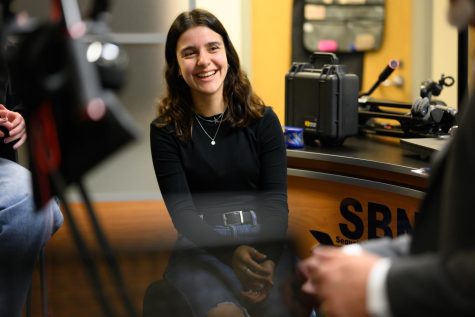EDITOR’S NOTE: What It Feels Like to be the Editor-in-Chief
Finding time to think about what it means to be someone or something captures the theme of this February issue.
Like everything else in life, there’s the good and the bad of being the editor-in-chief of the Tom Tom. Of course, there’s the frustrating layouts that never seem to get done. There’s the lost files that take hours to redo. There’s the staying after school until 9 p.m. to make sure every part of the magazine is edited and finished. But, like the most special and rewarding things in life, the good outweighs the bad. The relationships created make the hours of hard work more than worth it. There’s the meetings after school that turn into nights full of Chinese food and laughter with people you call family. There’s the unbelievable feeling of helping a writer, designer or photographer accomplish his or her goal. And, finally, there’s the feeling of working as a team to create a 36-page magazine and daily website that students, teachers, administrators, parents, grandparents, aunts, uncles and community members read, recognize and enjoy.
There are many words that can be used to describe an editor-in-chief, including confident, decisive, dedicated and empowering. Before becoming the Tom Tom’s managing editor then editor-in-chief, I did not think I portrayed these traits that are necessary to be the leader of a publication. However, throughout the past two years, I gained the leadership qualities I needed to be successful now and into the future from my fellow staff members and adviser. I learned to make decisions and be confident in my ability to do so. I learned the value of dedication and motivation; nothing beats helping other Tom Tommers write stories, take photos and design layouts that they are proud to share with their friends and family.
Recently, the Tom Tom was fortunate to have the amazing opportunity to Skype with bestselling author and award-winning journalist Mike Sager. Throughout his career, beyond his ample experiences interviewing and writing about celebrities (like Paris Hilton and Kobe Bryant) and everyday people, he wrote and edited multiple “what it feels like” stories that appear in Esquire magazine’s What It Feels Like anthology. He encouraged each member of the staff to take on the challenge of writing their very own “what it feels like” story, which is what the theme of this issue became. And, as always, February’s magazine contains many diverse and relatable features, such as what it feels like to be the new kid, to be a freshman on varsity and to love and be loved. And we also explore darker topics, such as what it feels like to have an eating disorder, to have an anxiety disorder, to have depression or to get into a life-threatening accident and get back up again.
In addition to Sager’s mentorship this issue, we also asked our adviser, Mr. Johnson, to write and work through the process of writing these stories with us. We felt that if there was ever going to be an issue where we could experience writing with him first-hand, it would certainly be this one. He was able to relearn what it feels like to be a journalist, and the story he crafted along with us is featured in this magazine. This experience allowed us to learn so much more authentically, as well as gave us an opportunity to further cement why we are so fortunate to have Johnson as our teacher, adviser and mentor. To Sager and Johnson, we thank both of you for challenging us this issue to go beyond the basics and focus on what matters: the stories.
This issue does not have sections. This issue does not have a One|Sequoit. This issue does not have a staff editorial. And, this issue is not written in third person. These stories are told in the first person and will not have traditional bylines of our staff members. Instead, the bylines will be those of the person who experienced the story, telling the story about what it feels like to ___. This issue is not about us. This issue is about a conversation. Each story is a result of multiple hours of interviewing. Each story is written by a journalist using the voice and story of the source. These stories are beautiful, haunting and full of heart. We want you to feel and experience these stories first-hand and we want you to hear these stories from the voices that should be telling them: the people who experienced it.
This issue as about giving voices to the voiceless.
We hope you enjoy and get a taste of what it feels like.







